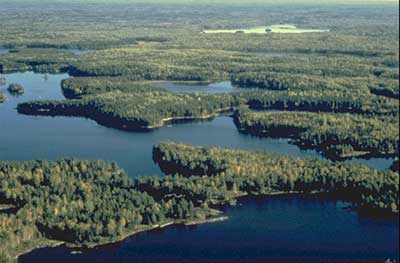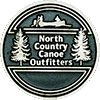
Carved by glaciers at the dawn of recorded time, the canoe country is a wilderness of lakes and forests stretching for 150 miles in northeast Minnesota along the Canadian border, between Lake Superior and Voyageurs National Park. These waters, first paddled by the Sioux and Ojibway Indians, were later explored by Europeans like Groseillers, and de Noyon. In the summer of 1660 Pierre Radison wrote “Out there we were kings, the richest men in all the world!” Portages between the lakes used by the French trappers and voyageurs of the Hudson’s Bay Company remain unchanged.
Your canoe will glide silently past beaver working on their dams and lodges as you journey through their timeless domain. White and yellow waterlilies blossom along these waterways just as they did when the English and French traders paddled this network of lakes and streams. The bald eagles and loons seen by native Americans centuries are still regular sights. At the waters’ edge are the moose and deer which roam the north country. Along these shorelines you might spot mink, otter, black bear, bobcat, pine martin, fox, and if you are very lucky … you might even catch a glimpse of a North American grey timberwolf.
You will paddle through lakes and rivers that show endless variety. Some lakes are over 20 miles long and 250 feet deep. Others have turned into shallow marsh ponds. Cliffs rise 200 feet over some waters; white sand beaches border a few. Rocky islands and peninsulas are common landmarks for paddlers. Waterfalls and rapids roar as water passes from one lake to the next. To bypass these hazards you will trade places with your canoe: now you must carry it rather than it carrying you. After traversing the portage (French for “the carrying place”), you will again paddle the waterways which would eventually lead you to Hudson’s Bay.
Waterfalls, pine and birch forests, and sheer rock cliffs form beautiful backdrops in this photographer’s paradise. Whether your interests are that of the fisherman, naturalist, camper/canoeist, historian, or photographer, you will be fully prepared for your north country wilderness experience.
Speaking of fishing, the cool crystal clear waters of the north country can provide fishing that is beyond compare. Whether you work your lure along rocky shores or in weedy bays, you will be rewarded with the finest freshwater game fishing in North America. If a delicious dinner of golden brown filets is your idea of good eating, then take advantage of the abundant walleye which prowl the rocky lake bottoms and submerged reefs. Cunning largemouth bass lie in log filled bays of some special lakes ready for a pole bending fight. Savage northern pike are waiting to tear into your tackle. And the cold waters found during spring and fall trips hold tasty lake trout in the shallows. But the experts all agree that the scrappy smallmouth bass found along rock ledges and below waterfalls are reason enough to fish the transparent lakes of the north country.
As part of the Superior National Forest, the Boundary Waters Canoe Area Wilderness (BWCA) is federally protected to preserve this national heritage and make a rare wilderness experience available to those who occasionally feel the need to escape to a different kind of life; life in the outdoors, unfettered by most man-made improvements. The BWCA, itself, is preserved in a natural state without roads, shelters, electricity, telephones, trash cans, or other amenities offered in most camping areas. As part of the National Wilderness System, the BWCA is the only lakeland wilderness area in the country.
Just over the international border with Canada is Quetico Provincial Park. Visitors can paddle between the two canoeing areas after making a pre-trip Canadian Customs Clearance application (not required for fly-in trips). Also, it is necessary to make a stop at a Park Ranger Station when entering. The areas are similar in appearance and operation, but the camping fees are significantly higher on the Canadian side.
